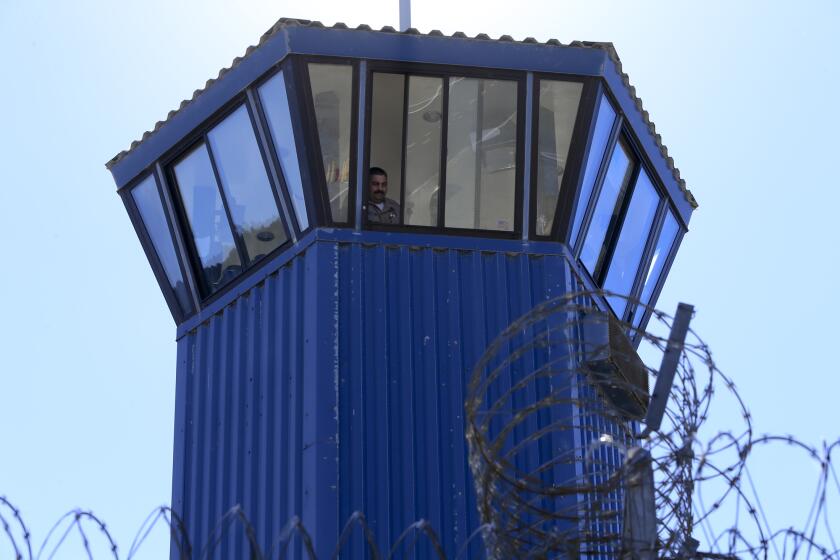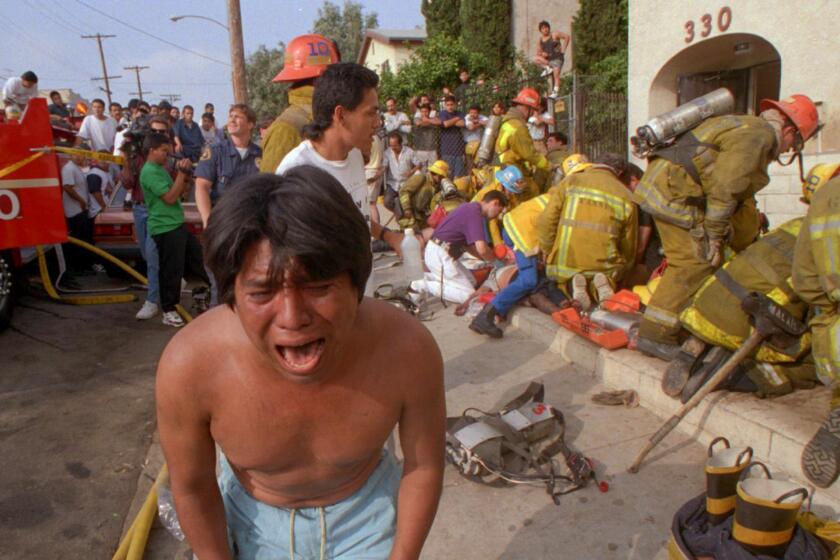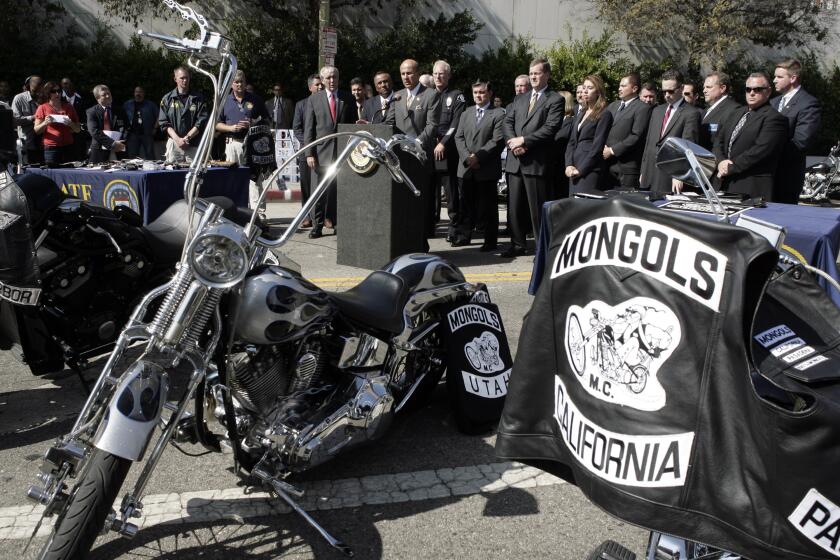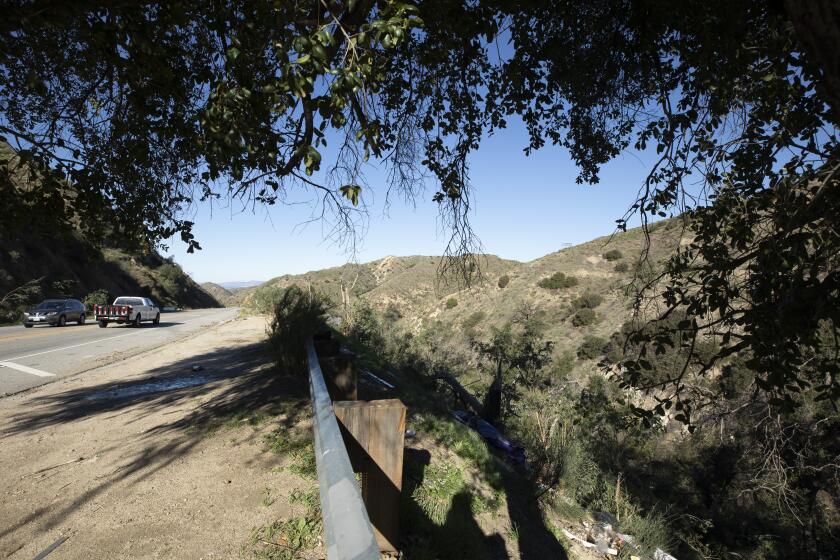‘Right out of “Macbeth”’: A woman’s killing shines light on Mexican Mafia power struggle in Inland Empire
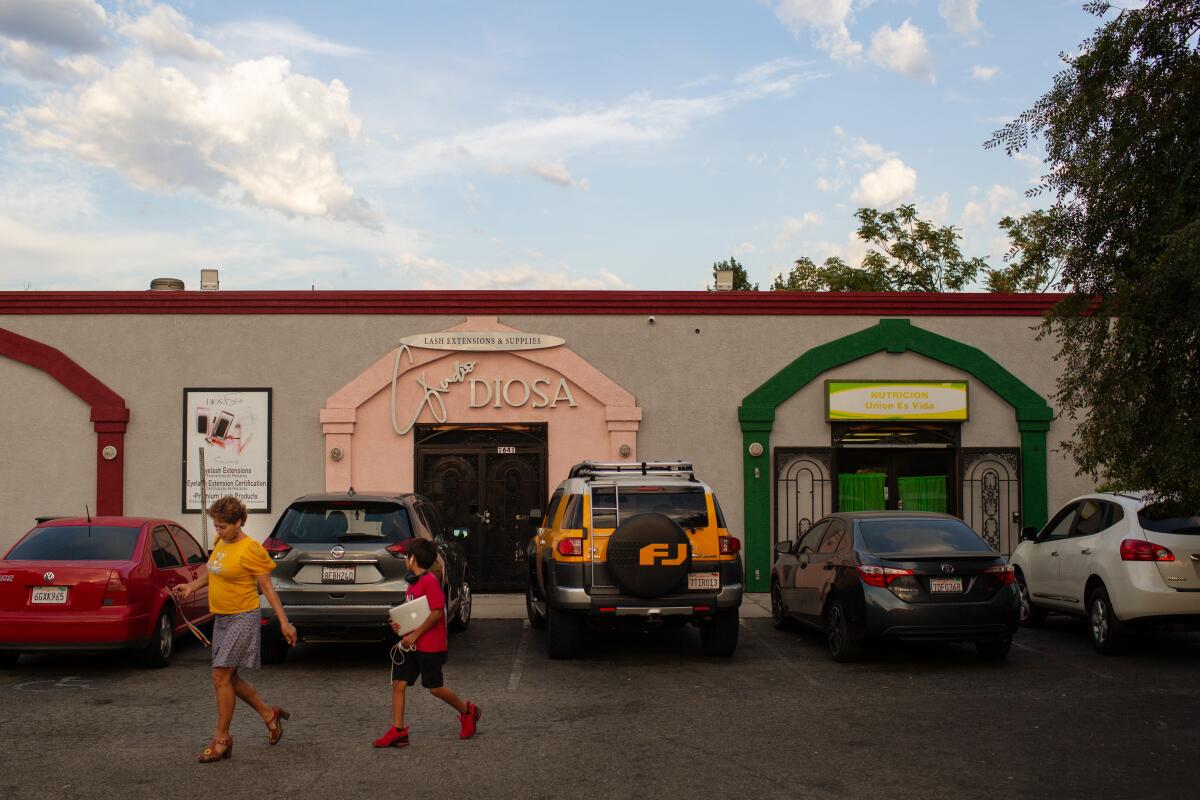
- Share via
Rain fell on the body of a woman in the parking lot outside Gaby’s Cafe, a hole-in-the-wall Mexican restaurant in San Bernardino.
The killing merited only a few lines in the San Bernardino Sun the next day: “The woman suffered several gunshot wounds to the upper torso. Paramedics performed CPR on the woman before an ambulance sped her away.”
But for those who knew Carmen Rodriguez — and who she was married to — her murder that night in January 2017 was incomprehensible. Her husband, Andrew “Huero Verde” Rodriguez, a member of the Mexican Mafia and a leader of the Westside Verdugo street gang, was arguably the most powerful figure in the San Bernardino underworld.
Carmen Rodriguez, authorities would learn, had not been the victim of some domestic dispute or a random crime, but an assassination ordered by others in the Mexican Mafia and carried out by Rodriguez’s underlings in Westside Verdugo.
One story of how Carmen Rodriguez was betrayed by her husband’s men unspooled this summer at the trial of her alleged killer. Whether it was the real story remains uncertain. The trial, which included dozens of witnesses and hundreds of pieces of evidence, produced as many questions as answers.
What the trial made clear is the power the Mexican Mafia holds over the gang members who do its bidding. Told to kill their boss’s wife, Andrew Rodriguez’s underlings did not hesitate to murder a woman who until the last minute of her life they affectionately called “tia” and “mom.”
The city of San Bernardino is divided by the 215 Freeway. To its east is downtown, the banks and courthouses and municipal buildings, the shuttered shopping center, the big-box stores. To the west is a pocket of small homes, dusty and sun-beaten, some tidy, others heaped with junk and debris. This is the territory of Westside Verdugo.
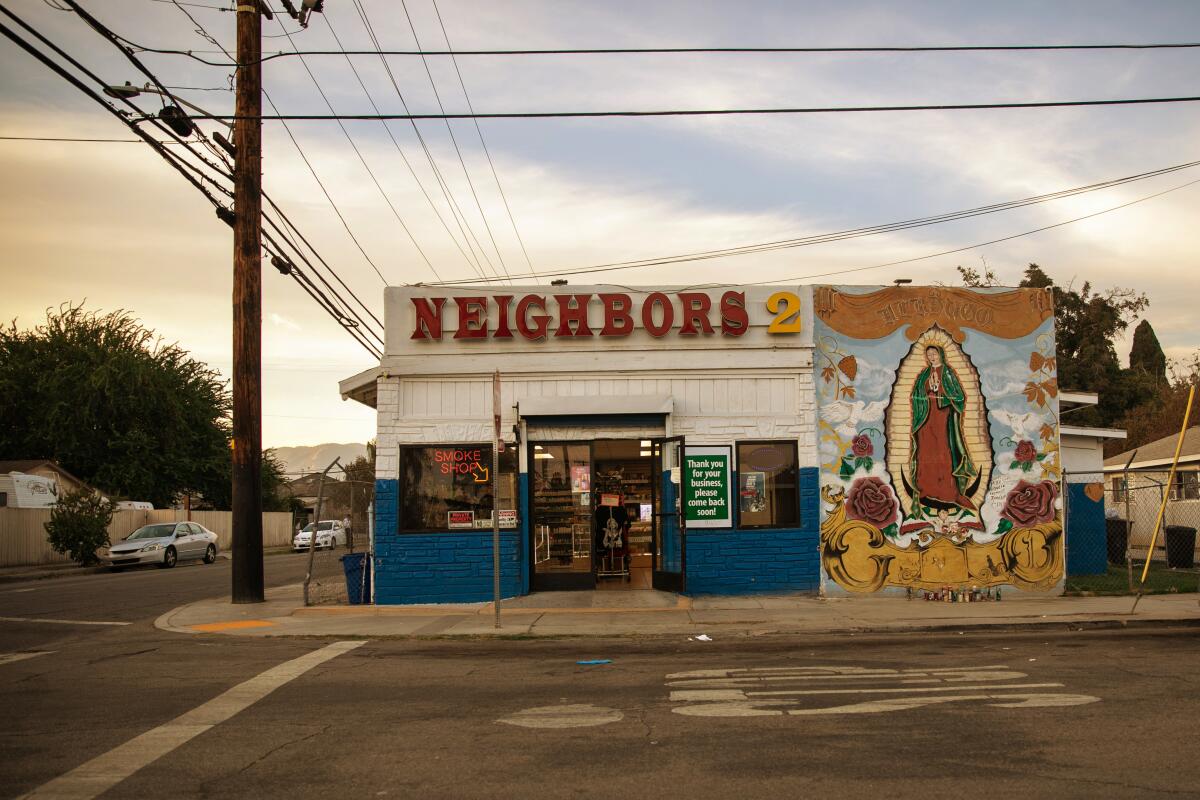
The gang is rooted in a collection of large families who have lived in the neighborhood and pressed on with internecine feuds “through generations, through decades,” said Leo Duarte, a retired state corrections official and Mexican Mafia expert who was raised on the west side of San Bernardino. “That’s all they know. They grew up in the varrio and they stayed there.”
Luck runs out for Donald “Little Man” Ortiz, who refused offers of protection after being banished and marked for death by the powerful Mexican Mafia.
The neighborhood was once home to working-class Latino households supported by decent-paying jobs with the Santa Fe railroad, Kaiser Steel and Norton Air Force Base. But between 1983 and 1994, all three employers moved or shut down. Thousands of jobs vanished.
“Once they shut down Kaiser, Santa Fe, Norton, everything went down,” Duarte said. Some households relied on government assistance to make ends meet, he said, while others turned to crime. “You don’t have a thriving economy, you have people out of a job, you’re going to have crime,” he said. “And you know what the biggest caper is? Drugs.”
Some parents chose drugs over their kids, “so the kids kind of clique up,” a lifelong member of Westside Verdugo testified at the trial of Carmen Rodriguez’s accused killer, explaining how his subset of the gang, Sur Crazy Ones, was born. “That’s what the Crazy Ones started as, family.”
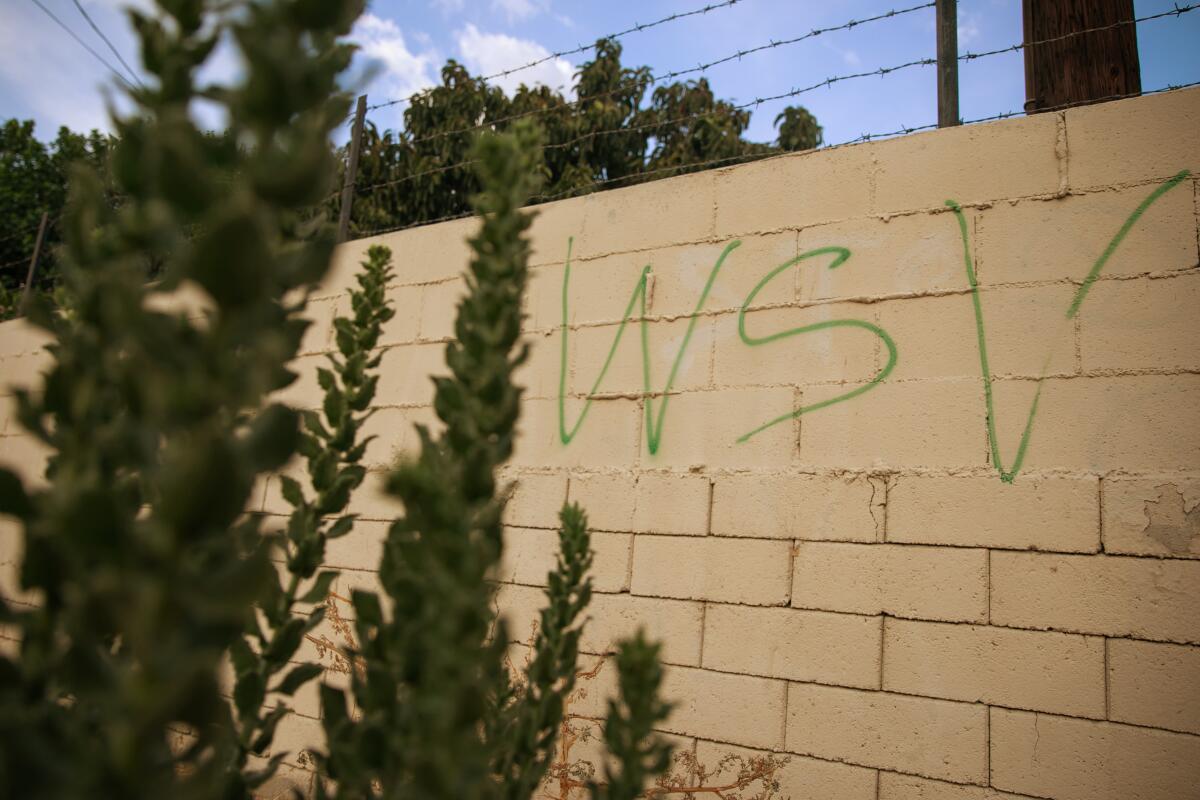
Like most Latino gangs in Southern California, Westside Verdugo is subservient to the Mexican Mafia. Sometimes called a “gang of gangs,” the organization is composed of about 140 men, nearly all of them incarcerated, who control Latino gang members in prison and collect taxes from gangs and drug dealers on the street.
A well-built man who wore a goatee and dark glasses, Andrew Rodriguez was in his early 40s when he was inducted into the Mexican Mafia around 2009. He was a decade into a life sentence he received for holding up a Sears and a sporting goods store in San Bernardino — his third felony conviction.

Subscribers get exclusive access to this story
We’re offering L.A. Times subscribers special access to our best journalism. Thank you for your support.
Explore more Subscriber Exclusive content.
In some circles of his hometown, Rodriguez was revered: A detective recalled at the trial raiding a home on San Bernardino’s west side and finding a photograph of Rodriguez propped up on a shelf, the Mexican Mafia’s black hand tattoo across the front of his throat.
Rodriguez was the first Westside Verdugo member to be inducted into the Mexican Mafia in 15 years. His ascent offered his gang a chance to turn the page on a tortured past with the organization.
The last member of Westside Verdugo to join the Mexican Mafia was Phillip “Chano” Chavez. Paroled from Pelican Bay State Prison in 1995, Chavez returned to his neighborhood intent on settling an old score, a San Bernardino detective wrote in a memo reviewed by The Times.
Chavez had harbored a grudge against another member of the gang, Johnny “Leche” Gutierrez, since the two were teenagers, according to the memo. He believed Gutierrez had told the police about a robbery that got him sent to the California Youth Authority.
The trial of a former L.A. gang member for the deaths of 10 in a 1993 fire was a step back to a time when gangs turned entire blocks into drug bazaars.
Chavez ordered Gutierrez’s nephew to kill him. When he refused, Chavez had another Westside Verdugo member gun down the nephew, the memo said.
Three weeks later, Chavez and two others were shot to death outside a home on San Bernardino’s west side. According to records reviewed by The Times, one of Gutierrez’s brothers told authorities that Gutierrez had shot Chavez, who then crawled under a van. The brother recounted dragging Chavez’s body out from under the vehicle to check it for bullet holes.
After Chavez was killed, the Mexican Mafia put a “green light” on Westside Verdugo members — an order for other gangs to attack them behind bars and on the streets, according to prison records. A month later, Gutierrez was found shot to death in the driveway of a San Bernardino home. He was wearing latex gloves and carrying a Mini-14 rifle, according to the detective’s memo.
His own gang had killed him to lift the green light, informants told police.
This summer, a sheriff’s deputy led a short, stocky man in a green jumpsuit to the witness stand of a San Bernardino courtroom. His hands were shackled to his waist. His neck and shaved head were so covered in tattoos they appeared a blue-green.
For safety reasons, the prosecution’s star witness was identified only by his nickname, Goo Goo. In exchange for a 25-year prison sentence, the 47-year-old had agreed to plead guilty to manslaughter, admit he’d set up Carmen Rodriguez to be murdered and testify against the men accused of helping him do it — including two of his childhood friends.
In 2016, Goo Goo told the jury, he was released from prison. His first day out, he got a call from a fellow member of Westside Verdugo who was still incarcerated, Eric “Green Eyes” Moreno.
Moreno gave him the responsibility of being the “llavero,” or key-holder, for Westside Verdugo. As llavero, he was to collect taxes and deliver the money to their boss, Rodriguez. Goo Goo said he had known Rodriguez, a distant relative, since he was a child, growing up around the corner from him and his brother.
‘Meeting with the enemy’: Was the leader of the Mongols motorcycle gang a double agent for the feds?
Three years after a federal jury convicted the Mongols of racketeering, a recording surfaced suggesting their leader had a secret relationship with the agent who led the investigation.
Moreno was Rodriguez’s “secretary” — a role once typically filled by women who were not in prison, who used visits and letters to pass messages from Mexican Mafia members to their underlings. But the proliferation of contraband cell phones in the state prison system has proved a “game changer,” testified Lt. Eddie Flores of the San Bernardino Police Department. Prisoners can now communicate directly with one another to arrange drug deals, order assaults and organize collection rackets, Flores testified.
Phones are smuggled in by correctional officers and “free staff” — plumbers, electricians, food preparers, Goo Goo testified. “I’ve seen nurses bring ‘em in, I’ve seen ‘em flown in on drones.”
A phone costs about $1,200 in prison, he said. “You kind of learn how these things work, the economics. If you’re bringing in too many cell phones, flooding the yard, the price drops.”
Goo Goo described his daily routine as Rodriguez’s man on the street: “I’d get up in the morning — it’s like going to work, having a job,” he told the jury. First he would call someone in the prison system, usually Moreno.
He thought he was going to meet a woman he’d been messaging online. But Bryan Cojon Tuyuc drove into a trap set up by the street gang MS-13, detectives say.
From his cell at the state prison in Calipatria, where he was serving 10 years for possessing an assault rifle, Moreno would tell Goo Goo what needed to be handled that day. “Patch this up here, that there,” he recalled. Deliver drugs. Pick up money.
His job took him across his boss’s territory, which at this point, law enforcement officials testified, comprised all of San Bernardino County and parts of Riverside County. “Sometimes I’d be in the car for two days straight,” Goo Goo said.
He testified that he collected about $500 a month from each of Westside Verdugo’s cliques and other Inland Empire gangs, such as Beaumont, Hesperia, Casablanca and Eastside and Southside Riva. He would turn over the money to Rodriguez’s wife, Carmen, who had married him in prison in 2015.
Goo Goo revered Andrew and Carmen Rodriguez, whom he called “tia,” or aunt. An ex-girlfriend testified that his phone’s background was a photograph of the couple. Hurt, she asked why it wasn’t a picture of her. “That’s my family,” she recalled him saying.
By 2017, Rodriguez’s standing in the Mexican Mafia had become precarious.
Some believe it was because he was close with Arthur “Turi” Estrada, a Mexican Mafia member from Rancho Cucamonga who had pushed for Rodriguez to become a member. After consolidating a grip on the drug trade in many California prisons and the streets of Riverside County, Estrada alienated others in the organization who, resentful of the money and influence he’d amassed, pushed to revoke his authority. Estrada eventually fell out of favor around 2015, lost control of his territories and saw his brother and right-hand man murdered.
One gang member, speaking on condition of anonymity for fear of reprisal, told The Times the tipping point came when Rodriguez sent a crew to Victorville to rob relatives of another Mexican Mafia member.
Whatever the reason, other Mexican Mafia members decided to put Rodriguez “on disregard,” meaning no one was to carry out his orders or deliver him money, Goo Goo and other witnesses testified.
But his wife was defiant and continued to collect taxes on his behalf, according to testimony.
The evening of Jan. 18, 2017, Goo Goo joined a conference call with Moreno and two other inmates, Richard “Easy” Garcia and Matthew “Nips” Manzano, who were on cell phones in different prisons.
Goo Goo had known Garcia, who was serving life in prison for murder, since they were teenagers coming up in Westside Verdugo’s Sur Crazy Ones clique. Manzano had been sentenced to life without the possibility of parole for killing two men in 2005.
Moreno led the meeting. He said he’d received an order to kill Carmen Rodriguez, Goo Goo testified. Everyone went quiet.
“I told them, ‘Are you sure? Are you sure this is the right thing?’” Goo Goo recalled. He said he asked “if there was any other way this could be handled.” Moreno said no.
Authorities believe several members of the Mexican Mafia voted to kill Carmen Rodriguez, Lt. Mike Martinez of the San Bernardino County Sheriff’s Department testified. They have managed to identify only Danny “Popeye” Roman, a major figure in the organization who was later stabbed to death in prison, Martinez said.
Moreno didn’t say who had ordered Carmen Rodriguez’s murder, Goo Goo testified, only that it needed to be done that night. Goo Goo would lure her to her death. Moreno said he’d already talked to the man who would kill her, Isaac “Crook” Aguirre, Goo Goo testified.
Twenty years earlier, Goo Goo testified, Aguirre had been accused of having “dry-snitched” in a murder case — trying to get another member of his gang to incriminate himself on a recorded jail phone. The allegation had hung over his head ever since. Killing Carmen Rodriguez, Goo Goo testified, was “the only way to get out of bad graces.”
After the phone call, Goo Goo said he met with Aguirre, who “didn’t really have too much to say about it. Mr. Aguirre, he was just in a bad spot.”
Goo Goo testified he handed a .38 revolver to Aguirre, who angrily told him that Moreno, Garcia and Manzano wanted to be on the phone listening as he killed Carmen Rodriguez.
“It was a messed up thing to begin with,” Goo Goo said. “I wasn’t happy about it. I knew he wasn’t happy.”
Goo Goo lured in Carmen Rodriguez by saying he had money to give her. From prison, Moreno and Manzano sent her directions to Gaby’s Cafe. “OK moms,” Manzano wrote in a WhatsApp message, adding a smiling emoji. “Just want it to be easy for you.”
Goo Goo was waiting in a Mercury Grand Marquis when Carmen Rodriguez parked two spots away, her 14-year-old daughter in the passenger seat of her Hyundai Elantra.
She got out and started to walk toward him. In the back of his mind, he said, he wondered if he too was about to be killed. He slumped down in his seat. “It’s a dirty game,” he told the jury. “It’s a dirty game. I’ve seen it happen before.”
Goo Goo testified that he heard five gunshots and saw Carmen Rodriguez fall to the ground. He reversed out of the parking lot and sped off into the night. Later that night, his then-girlfriend testified, Goo Goo picked her up at an abandoned home where she’d been staying and said he “did something horrible.”
On cross examination, Aguirre’s attorney, Melanie Roe, tried to get Goo Goo to admit that he had rolled down his window and fired the fatal shots himself.
“Wrong,” he shot back.
Roe argued that Goo Goo had dispassionately planned the murder of a woman he had affectionately called “tia.”
“I was disturbed,” he said, over and over. “Ma’am, I’m not an animal. I have feelings. I was disturbed.”
Jurors apparently did not believe his story. After a two-month trial, they acquitted Aguirre of murder. He walked out of court a free man in July after spending five years in jail. He declined to comment.
Manzano previously had been convicted of the murder and given another life term. Midway through his own trial, Garcia pleaded guilty to manslaughter and got 30 years on top of the life-without-parole sentence he was already serving.
Roe said she “absolutely” believes Goo Goo shot Carmen Rodriguez and criticized prosecutors for giving him a plea deal. A spokeswoman for the district attorney’s office didn’t return a request for comment.
Carmen Rodriguez was just the first to die.
Days after she was killed, Andrew Rodriguez’s brother, Perry, was found dead from a gunshot in San Bernardino. The killing was ruled a suicide, but Roe, who reviewed police reports of the incident, said the circumstances were suspicious to her. A lone witness left the scene, but then called police an hour later to report the death, she said.
Shunned by others in the Mexican Mafia, ignored by his own crew, his wife murdered, Andrew Rodriguez was himself found dead four months later in his cell at Pelican Bay, overdosed on heroin. Authorities suspect — but have never been able to prove — that he was killed with a “hotshot,” an intentional overdose.
The gangs he controlled and the monthly payments he collected were parceled out to other Mexican Mafia members, according to testimony and wiretapped calls played at trial.
“This is right out of ‘Macbeth,’ ” Roe said. “This was a murder committed for the purposes of a land grab, a territorial grab.”
And then there was Moreno. The night before he was to be brought to San Bernardino County to face charges of murdering Carmen Rodriguez, a guard at Kern Valley State Prison found the 30-year-old strangled in his cell.
Moreno’s cellmate, a member of Westside Verdugo serving a life sentence for torturing a man to death, has been charged with his killing. He was ordered by a Mexican Mafia member to kill Moreno, the only person who could name the people who had directed Carmen Rodriguez’s murder, before he got on the bus to San Bernardino the next morning, according to a law enforcement source and a Mexican Mafia associate with knowledge of his death.
More to Read
Sign up for Essential California
The most important California stories and recommendations in your inbox every morning.
You may occasionally receive promotional content from the Los Angeles Times.
